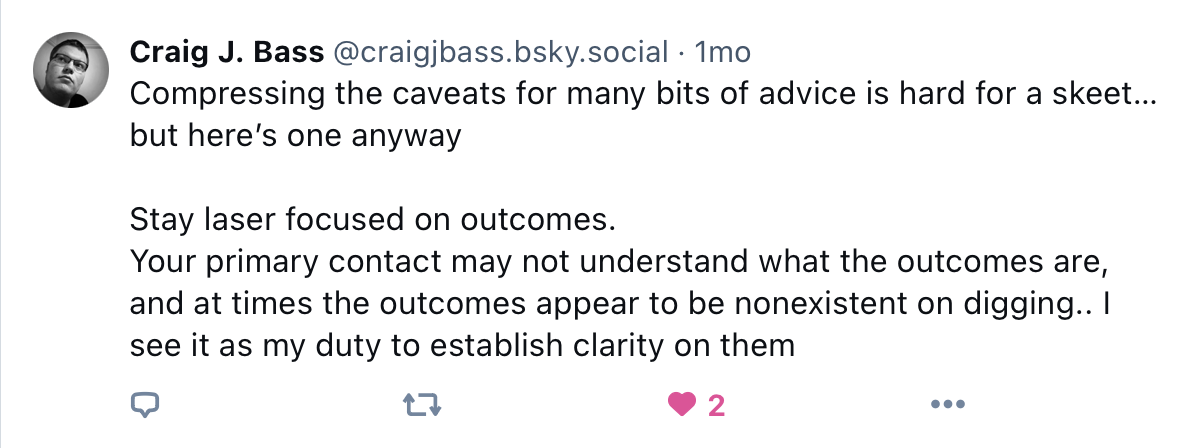Softwire Onboarding
I’ve been so impressed by the onboarding experience I’ve had at Softwire. It’s been a really smooth transition. They maintained regular communication during my notice period at Homes England, pulled together a clear plan for my first few weeks, lined up 121 conversations with a diverse group of people and the all important kit and access was ready and waiting for me.
Speaking to Elodie, Director of People, it’s great to hear how they applied an iterative approach to this. Designing and refining the onboarding process based on feedback from new hires over a period of time. Sometimes ‘internal’ processes like this can be overlooked but this approach ensures that the onboarding process stays relevant and effective in preparing new employees for their roles.
Moving to Consultancy
Talking about onboarding, having predominantly worked client side, I asked the community on BlueSky for any advice they could share with me about moving over to the consultancy side.



Consulting requires active listening, being honest with insight, respecting client decision-making, and applying principles. Effective change involves changing behaviours and not just processes, and prioritising outcomes. Speaking to Matt, he told me that having empathy for civil servants, having just been one is like a superpower.
As someone who’s just left a relatively large organisation in Gov, the 4th point from Tom particularly resonates!
‘Changing processes without changing behaviours changes nowt’
An example that springs to mind is when we first introduced User Researchers to delivery teams. We experienced so many challenges:
- Convincing stakeholders to give access to real users
- How and when do we incorporate feedback
- User Research vs Usability Testing
- Who decides how we prioritise user feedback vs business requirements
- A new way of working for the delivery team itself
Like a lot of change, resolving this takes some immediate steps like clear communication, collaborative processes, clear roles and responsibilities and regular feedback as well as medium to longer-term strategies like training, leadership advocacy and measuring impact with data to truly integrate and embed new ideas.
This has probably happened to you when trying to implement new or change existing governance, ways of working, recruitment, procurement or technology process. This demonstrates any change, no matter how well-intentioned, is difficult to embed successfully in isolation.
Learning & Development for Delivery
One of the topics I recently covered at a Delivery COP was the different training options available to public sector departments for delivery practitioners (although I’m sure can be extended to other professions and types of organisations).
I think taking a multi-pronged approach to training is the best approach to promoting continuous learning and development within the team.
This will not only enhance individual skills but also improve the overall effectiveness and efficiency of service/project delivery. It also helps with employee retention as it demonstrates a commitment to employee growth and progress.
This can be broken down to 4 parts:
1. Clear roles and responsibilities
Clearly articulate the different responsibilities between grades i.e. Associate, Mid, Senior and what is expected (on paper, in practice this is very fluid). To provide focus and to help identify which areas to target.
https://ddat-capability-framework.service.gov.uk
2. Clear guidance
A single source, accessible by everyone (ideally public). Should be iterated over time. Really good for new starters, incoming suppliers/contractors and existing people to use as a reference point.
Comprehensive guidance at DfE – https://design.education.gov.uk
3. Informal training
- Agile coach. Can help prioritise learning paths, identify the correct audiences and the most appropriate medium to share the information. Great way to bring in expertise who can pinpoint and deliver targeted training. Also great for 121 coaching.
- Clinics. Short lean coffee style drop-in sessions on quiet days to troubleshoot any specific issues teams are facing
- Lunch ‘n’ Learns. Cover a syllabus of topics ranging from Lean and UCD to Accessibility. These sessions should be recorded and made available to the whole team.
- Communities of Practice. Informal water cooler-type conversations between practitioners rather than structured meetings with topics or progress updates. Share nuggets, articles, and pain points. Divide and conquer. Collectively grow.
- Shadowing. Good opportunity for junior members of the team to learn by observation, build confidence and apply learnings alongside experienced colleagues who also benefit.
4. Formal training
- External course. Courses/certifications I would recommend:
- Certified Scrum Master
- ICAgile Project And Delivery Management
- ICAgile Coaching
- Lean Agile Leadership
- Internal classroom. Small groups of 5 or 6 people covering specific topics. Can be led by internal people who have certifications or an Agile Coach.
- Online learning. Important to create specific learning paths otherwise very easy to get lost in a sea of courses and also try to have some control over areas of focus.
- LinkedIn Learning. Formerly Lynda.com, this has a substantial library covering technical concepts and managements skills i.e Leadership, Communication, Management
- Udemy/Code Academy. Tailored towards technical courses.
- Pluralsight. A middle ground. This is what I used at Homes England to curate specific learning paths for different grades of Delivery Managers.
This is a long list of potential options and what route(s) you take will be determined by the size of your teams and what stage of, for the lack of a better word, maturity you are at.
For example, if you’re a small digital team largely reliant on suppliers, you may want to utilise that expertise by focusing on roles and responsibilities, shadowing and sending people on formal training. If you have a large community of people, clear guidance and online learning is a cost-effective approach to delivering training at scale.

One response
[…] been one month since I joined Softwire. The first two weeks were largely filled with onboarding, inductions and meeting new […]